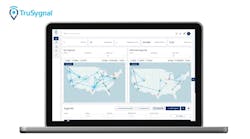The growth of e-commerce shipments has many more fleets emphasizing last mile deliveries. For congested metropolitan areas such as Seattle, the focus is actually on the “final 50 feet” of those shipments.
A joint study issued earlier this year by the University of Washington and Seattle Dept. of Transportation found e-commerce and urban growth has led to a dramatic increase in the number of vehicles circling the urban core. Without steps to correct inefficiencies, the number of truck trips in the downtown area of Seattle could double by 2023.
The study found the most difficult part of the entire delivery is often from the truck to the door inside the office or residential building —referred to as the “final 50 feet.”
Part of the problem is that only 13% of buildings in the study area feature private loading bays or docks, requiring delivery trucks to use curb and alley spaces. These spaces are frequently occupied by other delivery drivers, or by Uber and Lyft vehicles waiting to pick up or drop off passengers.
The study also found that clearing security accounted for 12% of total delivery time, while riding the freight elevator and looking for tenants’ locations accounted for 61% of overall time.
Researchers said a priority should be to reduce the number of “failed first delivery attempts,” which force carriers to take the package back out of the customer’s building, reprocess it, and try to deliver it again or ship it to an alternative site.
Reducing failed first deliveries mean “delivery trucks could make up to 15% fewer trips while still completing the same number of deliveries.” It could also improve online shoppers’ experiences, protect retailers’ brands, and cut logistics costs.
The study recommended higher usage of smart-locker systems, which would make deliveries easier and faster, said Barbara Ivanov, chief operating officer of the Supply Chain Transportation & Logistics Center at the University of Washington.
“They pull in, they load the locker or hand everything to a concierge or mailroom, and it cuts all of that transaction time out,” said Ivanov, who worked on the study.
Data found a smart locker system in the loading bay level of the 62-story Seattle Municipal Tower would reduce the time delivery people spend in the building by up to 73%.



